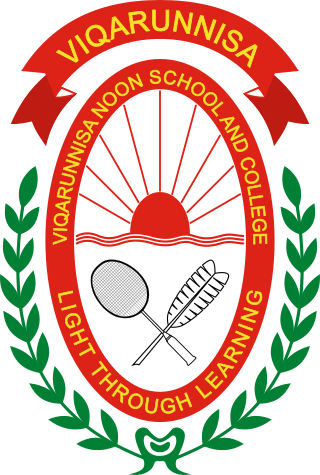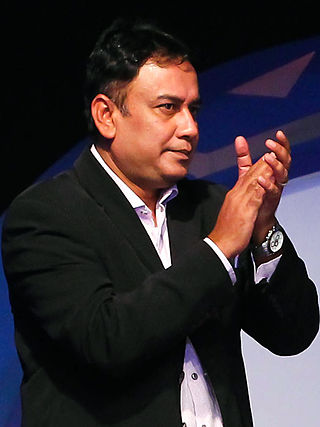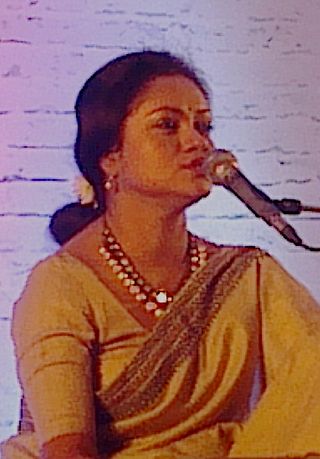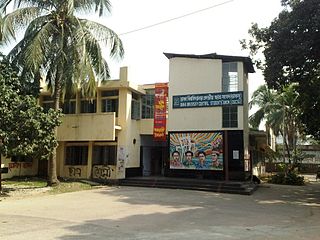
"Amar Sonar Bangla" is the national anthem of Bangladesh. An ode to Mother Bengal, the lyrics were written by Bengali polymath Rabindranath Tagore in 1905, while the melody of the hymn was adopted from the Baul singer Gagan Harkara's song "Ami Kothay Pabo Tare" set to Dadra Tala. The modern instrumental rendition was arranged by Bangladeshi musician Samar Das.

Viqarunnisa Noon School & College, also known as VNSC, is an all-girls higher secondary school and college in Dhaka, Bangladesh. It has 25,000 students at four campuses in the city. It is named after Viqar un Nisa Noon.

Atish Dipankar University of Science & Technology, abbreviated as ADUST, is a private university in Uttara, Dhaka, Bangladesh. The university was named after Atish Dipankara Srijnana, the ancient Buddhist scholar.

Uttara Model Town or simply Uttara is a neighbourhood of Dhaka, the capital of Bangladesh. The name derives from the Bengali word uttor meaning "north". It lies on the road to Gazipur, and adjoins Hazrat Shahjalal International Airport.

The Bangladesh Chhatra League, formerly known as the East Pakistan Student League, often simply called the Chhatra League, is a students' political organisation in Bangladesh, founded by Sheikh Mujibur Rahman on 4 January 1948. BSL is the student wing of the Bangladesh Awami League.
Shironamhin is a Bangladeshi rock band formed in Dhaka in 1996. Following as a rock group emerging from Dhaka's underground music in the late 1990s, they were distinguished for their extended psychedelic and progressive compositions, multi-instrumental experimentation, and philosophical lyrics and became one of the leading band of the Bengali progressive rock genre. In 2008, the band became a member of the Bangladesh Musical Bands Association (BAMBA).

Shakib Khan, Bengali pronunciation:[ˈʃaːki:bxaːn] ;, also known by the initialism SK, is a Bangladeshi actor, producer, occasional singer, film organiser, and media personality who works in Bengali films, both in Bangladesh and West Bengal. He is widely regarded as one of the most popular and influential figures in Bengali cinema and is considered to be one of the most successful actors in the country's history. In his career spanning about two decades, Khan has been the propeller of the contemporary film industry Dhallywood. Currently he is the highest paid actor in Bangladesh.

Zahid Hasan is a Bangladeshi film, television and stage actor. He has been working as an actor in the show business arena of Bangladesh since the 1990s. He is also a TV commercial model. He was awarded Bangladesh National Film Award for Best Actor for his performance in the film Srabon Megher Din (1999).

Salimullah Khan is a Bangladeshi writer. Khan explores national and international politics and culture using Marxist and Lacanian theories. Informed and influenced by Ahmed Sofa's thoughts, his exploration of Bangladesh's politics and culture has a significant following among the country's young generation of writers and thinkers. Khan translated the works of Plato, James Rennell, Charles Baudelaire, Frantz Fanon, Dorothee Sölle into Bengali. In Bangladesh, he is a regular guest in talk shows on national and international political issues.

Jaaz Multimedia is a film production and distribution house in Bangladesh.

Anti Terrorism Raju Memorial Sculpture is a sculpture located in University of Dhaka campus of Bangladesh. It was created by Shaymol Chowdhury and considered one of the best sculptures in Bangladesh. It is dedicated to the memory of a student of Dhaka University named Moin Hossain Raju an activist of Bangladesh Students' Union who was killed while protesting against Terrorism. It was built in the late 1990s.

Adity Mohsin is a Bangladeshi Rabindra Sangeet singer.
EXIM Bank Agricultural University Bangladesh is the first private agricultural university in Bangladesh.
Coolie is a 1997 Bangladeshi Dhallywood action comedy film, directed by Montazur Rahman Akbar and written by Abdullah Zahir Babu. AK Siddique produced the films under the banner of Flamingo Movies. The film stars Omar Sani and Sadika Parvin Popy leading role with supporting roles played by Amin Khan, Dildar, Humayun Faridi, Dolly Johur and more. The film actress Sadika Parvin Popy started her career with the film. It is a remake of the 1993 Tamil film Chinna Mappillai.

Dhaka University Central Students' Union, also known by its acronym DUCSU, is the official students' union of the University of Dhaka. Called the second parliament of Bangladesh, DUCSU represents Dhaka University students in the university's decision-making, acts as the voice for students in the national higher education policy debate, and to provides direct services to the student body.
Shishir Bhattacharja is a Bangladeshi linguist, writer, columnist, and a professor of the French language at the University of Dhaka. He is also the Director of the Institute of Modern Languages, University of Dhaka. An ardent advocate and promoter of the Bengali language, he has written extensively on the use of Bengali in Bangladesh. He translated works of Guillaume Apollinaire, Arthur Rimbaud, and Bernard-Henri Lévy into Bengali and poems of Jibanananda Das into French.

Tagore University of Creative Arts is a private university located in Dhaka, Bangladesh. The vice-chancellor of the university is Syed Mohammad Shahed.

Shilaidaha Rabindra Kuthibari, in short Shilaidah Kuthibari, is one of the major tourist places in Bangladesh. It is located seven kilometers north of Kushtia on the banks of Padma in Kumarkhali Upazila of Kushtia District.















